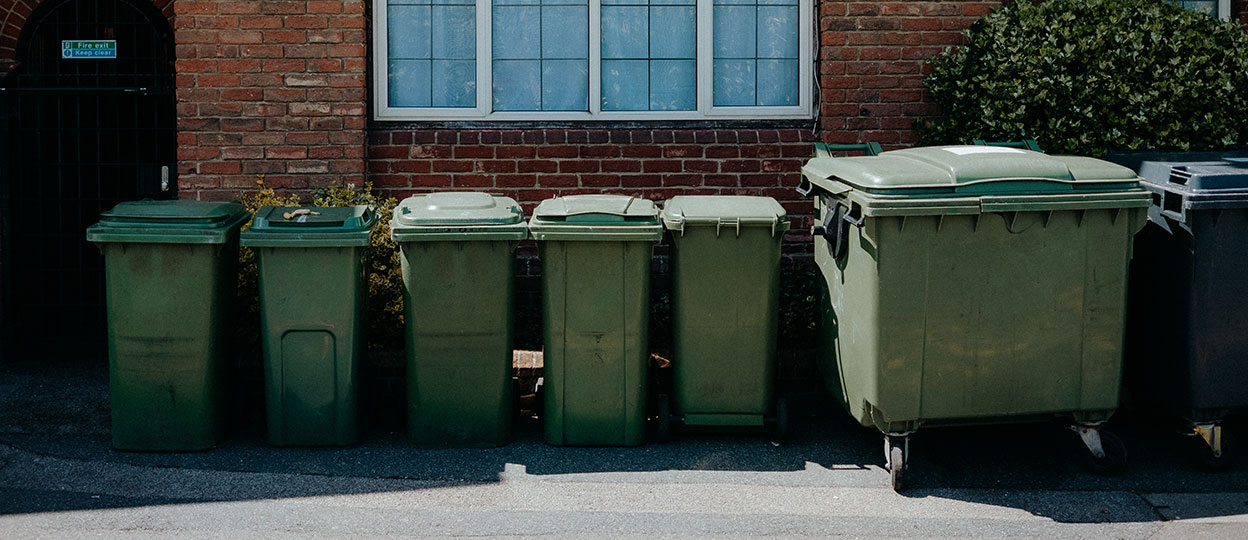The unverified Q3 2024 recycling figures released by the Environment Agency indicates strong recycling performance, with all materials exceeding at least 78.5% of their recycling obligation.
Looking back to the influence of 2023, all materials achieved in-year compliance last year except glass aggregate, but this shortfall was made up with excess glass remelt. The surplus across all materials, except glass aggregate, was significantly up on the previous year. This has put less pressure on achieving compliance for 2024 as excess PRNs produced in December 2023 were carried into 2024.
2023 recycling performance and 2024 carry-in (tonnes)
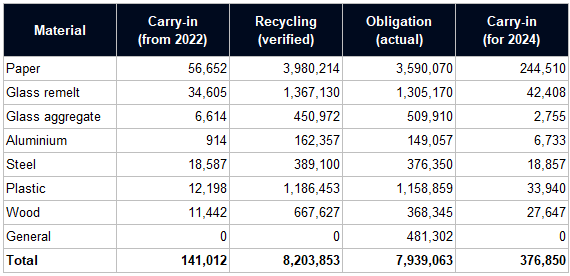
2024 recycling targets
As the packaging recycling business targets were largely unchanged from 2023 – with the major exception of wood which rose from 35% to 42% – PRN prices were generally expected to soften in the 2024 compliance year. The relatively high volume of carry-in further compounded this expectation.
2023 vs 2024 recycling targets
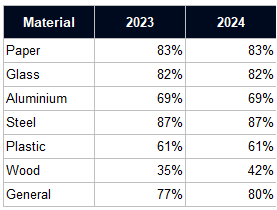
The lack of ambitious targets left some industry voices warning that we could see major decreases in plastic PRNs versus last year's highs of around £400. This has so far proved to be true.
Recycling performance in H1 2024
Overall, the Q3 data shows that recycling performance was fairly good across all materials. Factoring in 2023 carry-in, we are currently at 80.4% of 2024 obligation achieved – which is 5.4% ahead of target. Both glass materials have performed well but there is still some risk of non-compliance, especially compared to the strong performance of other materials. Wood has already achieved compliance with any additional PRNs being used for the General obligation. Paper also continues to track well at 91%, aided by a strong carry-in from 2023.
Q3 2024 recycling performance (tonnes)
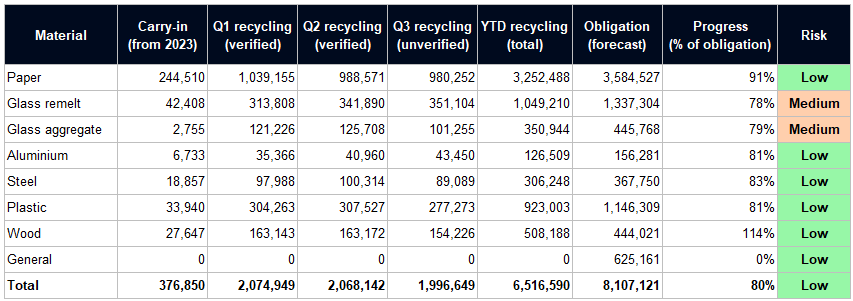
What does this mean for producers?
Glass - Medium risk

Glass recycling has had a turbulent start to the year. A number of new entrants to the aggregate market has meant strong availability and a softening of prices throughout the first three quarters of the year. In the last five years, there has been a shortfall in aggregate PRNs which have needed to be supplemented by remelt PRNs.
We should also note the re-alignment in glass PRN target splits this year (2023: 72|28 to remelt, 2024: 75|25 to remelt). The Q3 unverified performance in aggregate was the worst in the last five years. Despite this, aggregate remains ahead of last year's performance and has achieved 78.7% of the obligation to date.
Glass recycling target split

Glass remelt has had a more difficult start to the year. The Q3 unverified performance for remelt was about average compared to the last five years. Remelt is currently 3% behind last year's performance but remains ahead of the 75% target at 78.5% thanks to a strong carry-in from 2023. Both glass materials will remain a medium risk unless there are significant changes in the verified Q3 data.
Aluminium - Low risk
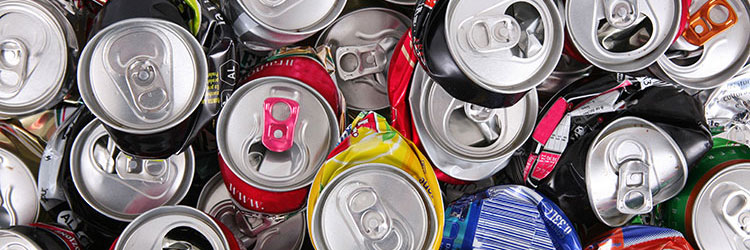
The unverified Q3 data for aluminium was far stronger than Q1 and Q2, putting aluminium in a positive position as we come to the end the compliance year. Looking at the last five years’ worth of data, 2024’s Q3 only just fell short of 2023’s record-breaking Q3 data set. Whilst we are 4.6% behind last year’s numbers, the good carry-in and reduced forecasted obligation puts aluminium at 80.9% of the obligation achieved.
Steel - Low risk

Despite three consecutive sets of poor monthly data, steel is currently at 83.3% of its forecasted obligation. Steel is currently 6% behind last years performance, but with the reduced obligation and strong 2023 carry-in, steel looks on track to achieve compliance.
Plastic - Low risk

After a turbulent 2022 and 2023, plastic has had a period of good through-put, strong recycling data and has also benefited from a good 2023 carry-in. Price peaks have been short-lived, and prices have generally been stable compared to the volatility seen in previous years.
There is very little to suggest any significant changes in the final quarter of the year – and little to no risk of not achieving compliance given the strong carry-in and performance to date. Whilst the Q3 unverified data was not strong, plastic is currently at 80.5% of the forecasted obligation.
Paper - Low risk
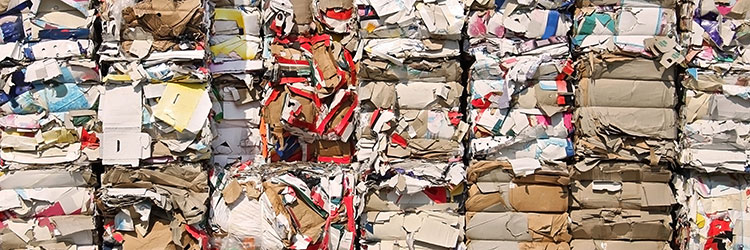
Similar to 2023, paper has had a good start to 2024 with strong monthly data combined with exceptional carry-in. Whilst 2023 started with high prices, we entered 2024 at a much lower price point. Notwithstanding macroeconomic factors at play, including the Red Sea Shipping Crisis in export-heavy materials, paper prices look likely to remain low throughout the rest of the year.
The continued strong performance in the quarterly data has resulted in the best performance in the last five years. Indeed, paper has already achieved 90.7% of this year's forecasted obligation and any excess will be used to fulfil the general obligation.
Wood - Low risk
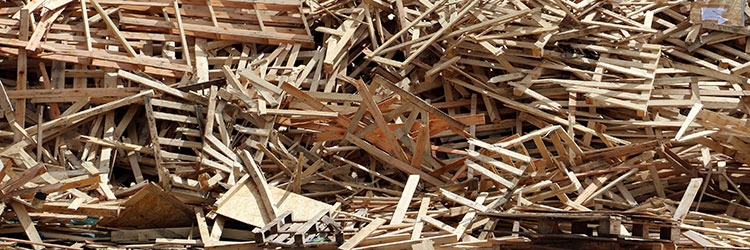
Wood follows a similar trend to paper where prices have remained stable and low since the start of the compliance year. It continues to perform well against its recycling target (which has increased by 7% YoY) and needs to continue this performance to fulfil the general obligation alongside paper.
Whilst the Q3 unverified data was weak and unexpected (the worst Q3 data in the last five years), this may be due to under-reporting and is unlikely to dramatically raise prices long term. Wood has already over-achieved its obligation at 114.5%, any excess will support the general recycling obligation.
Looking ahead to the second half of 2024
We will continue to communicate the changes in the PRN market throughout the year. Our members can understand the dynamics of the market with our interactive PRN market insights dashboard in the Ecosurety Hub. This provides a daily and year-to-date average material price and sophisticated insights into PRN market dynamics. This is updated daily to provide you the most up to date information.
